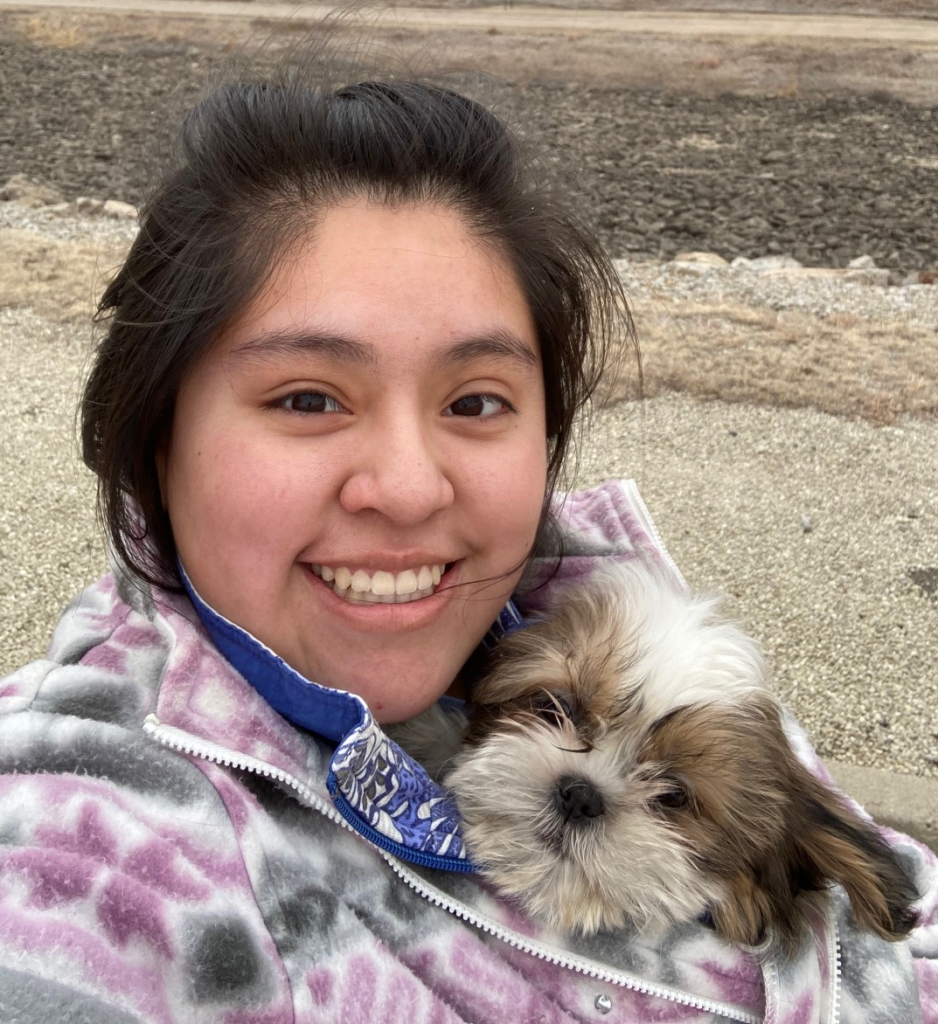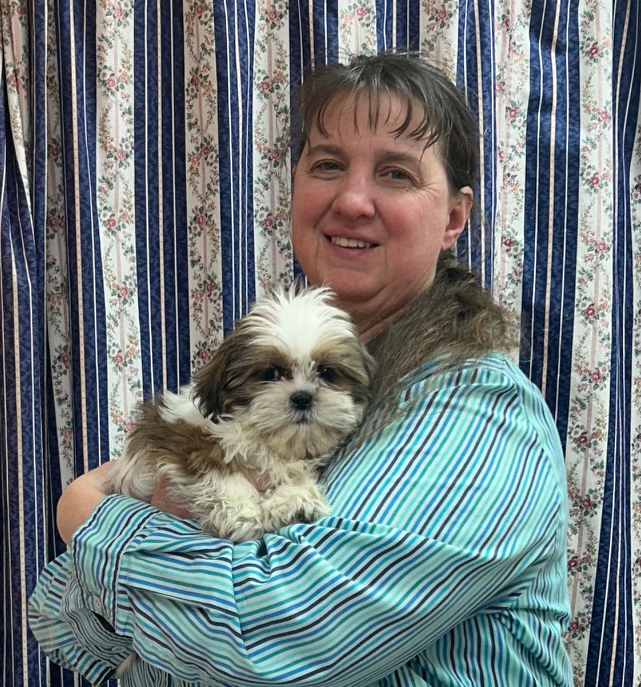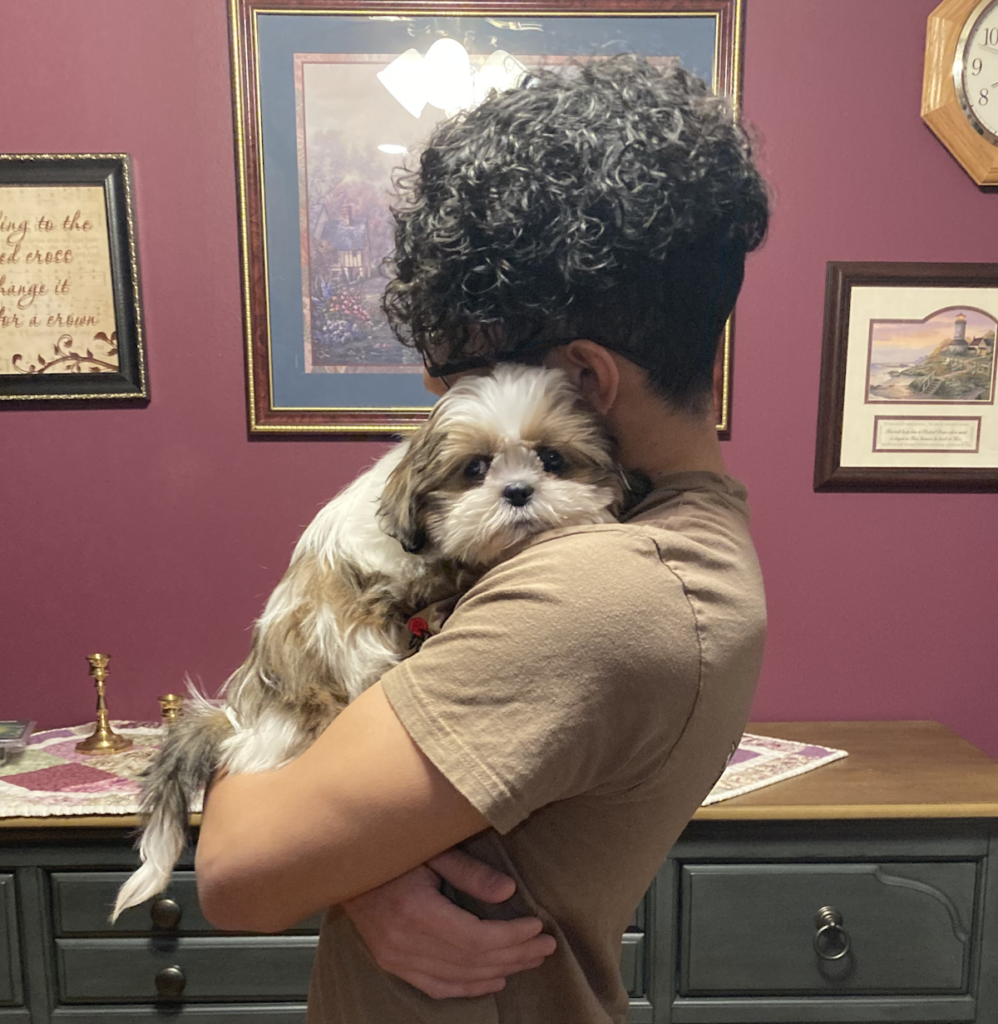Because this website is the essence of who I am, you, the reader, get a glimpse into my private life and things that have a profound impact on our family. Homestead life is not always happy, sometimes there is pet loss. Some losses, though, leave deeper impressions than others. Nothing prepares you for the heartbreak of losing a beloved family pet. Though our precious puppy. Daisy Mae, whose time with our family was brief, left an indelible mark on our hearts.
The day started like any typical morning for us in the recent weeks. I woke about 4:30 am; let Daisy Mae out of her kennel. She stretched and wagged her tail. I snapped on her leash, gave the bells at the back door a ring, and outside we went for her morning potty break. The crisp morning air chilled my legs immediately. I had on a coat, but was still wearing my sleeping shorts. She did well and earned a treat. We hurried back into the warmth of the house.
After being confined all night, Daisy was bursting with energy, ready to play. As I settled on the couch for my morning Bible reading, she romped about with her newest treasure – a small squeaky duck toy Teva had purchased. While endearing during the day, the shrill squeaks were less charming in the predawn with the others still sleeping.
With me being away for the day, Teva was in charge of the kitchen. Her responsibilities included preparing the ham hocks from the crockpot – deboning and chopping them for our ham and bean soup. She also packed her daddy’s lunch to take to work and handled the breakfast dishes.

Something Wrong
When I returned home late that afternoon and settled at my computer to work, I barely noticed when Teva took Daisy out for another potty break. It wasn’t until evening that I realized something was wrong. Daisy lay unusually still next to my office chair, and Teva cautioned me to not backward as she pointed to our puppy.
I scooped her up and immediately noticed her labored breathing. Questioning Teva about their earlier walk revealed nothing unusual – just a brisk pace about the drive. Unsure what ailed her, I simply held her close, hoping to comfort her.
By 8pm, she vomited her dinner, the contents included a worrisome trace of blood. I settled her in her kennel at midnight, adding an extra towel for accidents. At 4am I checked on her, and found that she had thrown up the remainder of her food. When I lifted her out of the kennel, she wretched again, this time producing a small mixture of mucus and blood.
A Desperate Search for Answers
I realized that Daisy May was one sick little puppy. I pressed Teva for more details. Had Daisy eaten anything unusual? Then, Teva recalled giving her a small bone from the ham hock, about two inches long. Daisy had cherished it, carrying it through the house as she gnawed contentedly. Our search failed to located the missing bone. I wondered if she had gotten it lodged in her throat or stomach.
After morning chores, I began calling our vet’s office. By 8:04 am, we had her at the clinic, where she weighed in at just 6.1 pounds. Leaving her for tests and observation, Teva and I ran errands and kept our morning pedicure appointments, with instructions for the vet to call my cell with updates.
A few hours later, Joey called and apologized for not hearing the phone. The vet’s office had left a message asking me to call them. When I called the clinic, the doctor was out on a farm call. Nearly an hour later, as our nail appointment concluded, the vet contacted me.

Devastating Diagnosis
The x-rays did not reveal any bone fragment or other obstruction. However, the vet expressed grave concern about Daisy’s breathing. He suspected aspiration pneumonia, possibly from inhaling vomit. Our pedicurist shared her own experience with a pug showing the same symptoms that didn’t survive.
Our vet recommended taking her to K-State’s veterinary clinic, suggesting Daisy might need oxygen therapy. When asked about the urgency, his response was unequivocal: “Now.”
Joey retrieved Daisy from the vet’s office while Teva and I rushed home to unload groceries. As Joey transferred Daisy into Teva’s arms, I saw that her condition had worsened – her breathing more strained. The drive to Manhattan seemed to take longer than it should.
I called ahead, giving the front desk my information. I took Daisy and we hurried to check-in. As I was speaking, Daisy suddenly gasped, her eyes back and her head went limp. “She’s stopped breathing!” I cried out. A “Code Blue” announcement came across the intercom. There was someone at my elbow, taking Daisy. She started breathing again before the lady took her from my arms.
Difficult Decisions
Dazed, I sank into a chair until a staff member guided me through completing paperwork. My mind reeled as they discussed payment options and had me sign forms I could barely comprehend. The laminated page said “read carefully”, but I merely skimmed and signed the necessary documents. Eventually, they ushered us into a private room where a veterinary student took Daisy’s history.
The attending vet explained the sobering reality: initial diagnostics and treatment would likely exceed $1,500, with no guarantees. They currently had Daisy Mae stabilized. The most painful question came next – did we want them to resuscitate if her heart stopped? Through tears, I declined, signing the DNR form. Teva and I were again left in the room, waiting, praying, hoping she would somehow be okay.

Final Hour
As we agonized over the fate of our little puppy, another staff member updated us. She said Daisy had stabilized, and they were prepping her for the oxygen cage. Then she stopped breathing again. Daisy had a lot of blood in her throat and nose. The lady told me that they offered cremation services, but I said we would take her home to the farm. They also said they could make a clay paw print, free of charge for us. Teva nodded her head, yes. I was a bit confused. So, was Daisy gone? The woman said she wasn’t positive, but it looked like Daisy would not make it. She said she would go check again, and if Daisy was still breathing she would come let us know.
The lady never came back. Instead, they brought Daisy Mae to us in a small white box. They had cleaned her up, and she looked like she was sleeping.
While waiting for the clay paw print to finish baking, I settled the bill and retreated to the restroom to wash the tears streaking my face.
Homecoming
It had been a difficult hour at the clinic, and we were ready to leave. I was thankful Teva was with me while my husband and Joey worked late. We brought Daisy home in the little box. Teva helped me dig the hole in the sticky soil. It was getting late. As the sun began to set, Teva and I buried Daisy beside Maple, our old milk cow. When I do chores in the mornings, I can look out to the sloped hill and think of Daisy.
For just three short weeks, Daisy Mae filled our home with joy. She adored fetch and invented her hilarious “Dust Mop” game – lying spread-eagle on the hardwood floors, gripping her rope toy while we pulled her around. Her playful spirit and funny antics has made a lasting impression on our lives.

The Unknown
The hardest part of Daisy’s loss is not knowing exactly what happened. Veterinary science confirms that sometimes, despite our best efforts and advanced diagnostics, answers remain elusive. Puppies’ small bodies can react severely to what might seem like minor incidents. Daisy Mae taught us that love isn’t measured in years, but in moments – and that the smallest lives can leave the biggest paw prints on our hearts.
Medical Insights
Although Daisy’s x-rays showed no bone fragments, some foreign objects remain undetectable on radiographs. Research indicates that radiography’s sensitivity in detecting small intestinal obstructions varies widely, ranging from 36.8% to 89.5%, depending on the reviewer. Undetected foreign bodies can still cause severe complications, requiring further diagnostic tools like ultrasonography.
Microscopic bone shards can create abrasions along the gastrointestinal tract without forming a detectable obstruction. These minute injuries often lead to localized inflammation and bleeding – potentially explaining the blood in Daisy’s throat.
Gastric acids may partially dissolve small bone fragments within hours, leaving only chemical irritation that triggers vomiting and respiratory complications. This dissolution process could account for both Daisy’s initial symptoms and the negative imaging results.
The physical act of vomiting itself can cause aspiration pneumonia in puppies. The violent reverse peristalsis may force stomach contents into the lungs, creating inflammation that progresses rapidly in small breeds.
The blood observed in Daisy’s nose and throat is consistent with cases of hematemesis in young dogs, where gastric irritation can cause capillary rupture in the esophagus, leading to secondary nasopharyngeal bleeding. This type of bleeding can make the vomit appear more severe than the actual blood loss.. Veterinary pathologists note that puppies under 12 weeks frequently present with this symptom complex following dietary indiscretion, regardless of radiographic findings.

Puppy Nutrition: Quality vs. Cost
The question of whether expensive puppy food is worth the cost comes up frequently among homesteaders who are accustomed to resourcefulness and careful budgeting. Research suggests that quality does matter, though not always in the ways marketing would have you believe.
High-quality puppy foods typically contain more digestible protein sources and fewer fillers. This means your puppy can actually absorb more nutrients from less food. The improved digestibility often results in smaller, firmer stools and potentially fewer digestive upsets. Mid-tier foods from reputable companies often provide the best balance between cost and nutrition.
The most expensive brands sometimes include exotic ingredients that add to the cost without necessarily improving nutrition. Meanwhile, the cheapest options often rely heavily on corn and wheat gluten that provide calories but less nutritional value. A middle-ground approach is having a dog food where meat is the first ingredient, grains are whole rather than by-products, and artificial preservatives are minimal
Proper calcium-to-phosphorus ratios are essential for bone development, especially for growing puppies. This is an area where properly formulated puppy foods might have an advantages over homemade diets or adult dog food. Read labels carefully and consult with your veterinarian rather than making decisions based solely on price.
Regular Veterinary Care
One lesson from Daisy Mae’s sudden illness was the value of having an established relationship with a veterinarian before emergencies arise. Regular check-ups allow vets to establish baseline health parameters and become familiar with your puppy’s specific needs. These routine visits also provide opportunities to ask questions about breed-specific concerns and preventative care.
Puppy First Aid Procedures
Veterinarians typically recommend learning basic emergency procedures: applying pressure to bleeding wounds, safe transportation methods for injured animals, and recognizing signs of choking or respiratory distress. Puppy owners should know how to take temperature readings and understand the normal ranges for puppies of different sizes and breeds. These skills can be critical during emergencies when immediate action might be necessary.
Consider programming your phones with contacts for both your regular vet and the nearest 24-hour emergency clinic. Keep a small fund set aside specifically for unexpected veterinary expenses.




